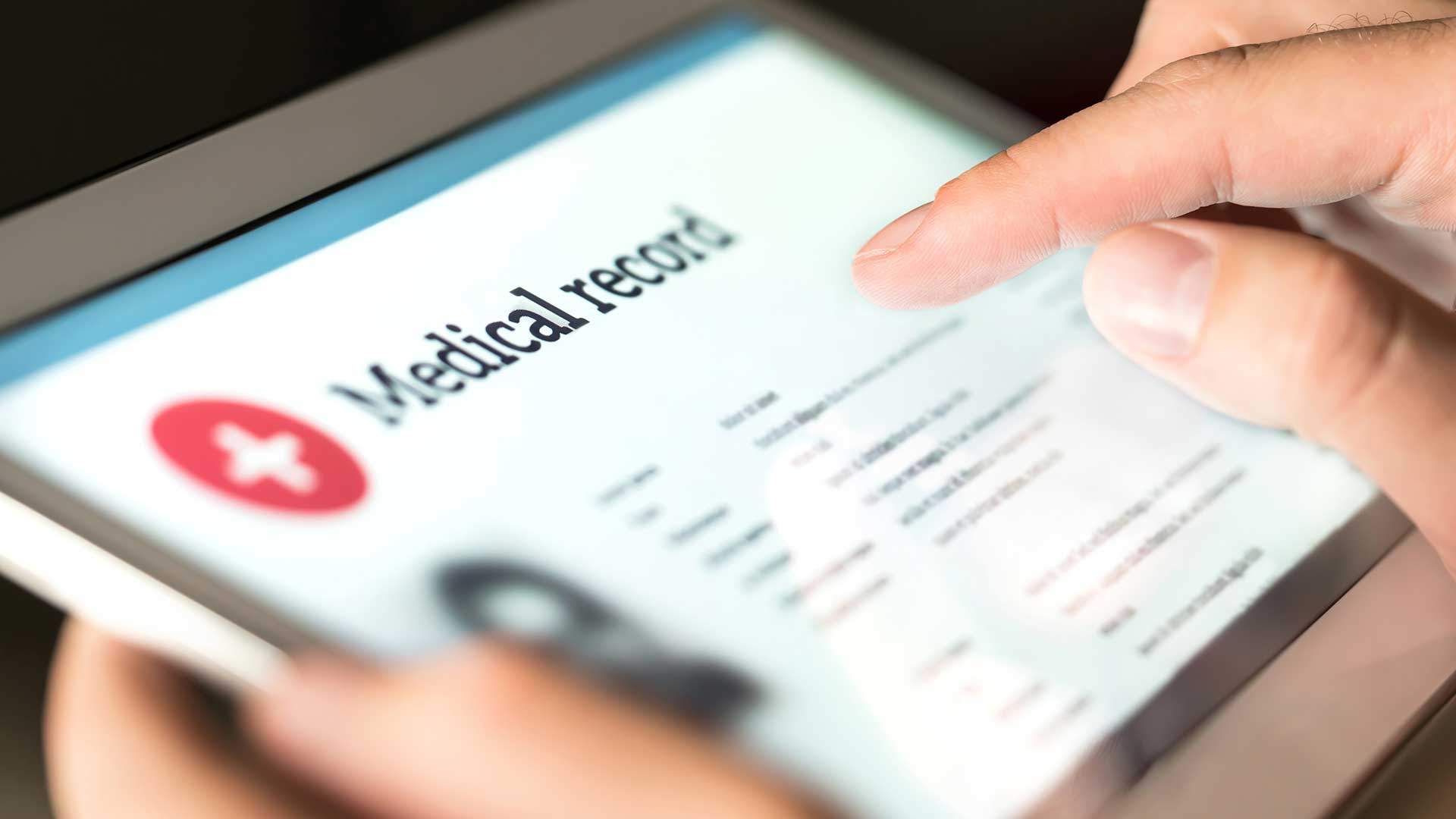Medical Records Scanning
The Definitive Guide for Scanning Medical Records
Learn everything you need to know about digital medical records and going paperless in your office.
Introduction
Managing a medical office comes with plenty of paperwork. According to the U.S. Environmental Protection Agency (EPA), the average person comes into contact with 4.9 pounds of paper daily, and U.S. offices use about 12 trillion sheets of paper annually.
At healthcare organizations, paper and printer ink are often among the top costs of doing business as each employee uses up to 10,000 pieces of paper per year in their daily work. Your staff also spends precious time dealing with all of that paper, including sorting, stacking, filing, and tracking down documents.
Plus, a medical office is legally required to archive records for several years. Even as new paperwork joins your massive mountain of documents, the old paperwork sits there for at least another 7 years under U.S. healthcare data preservation laws.
If you’re looking for a way to reduce your healthcare company’s reliance on paper, improve patient care, and use your limited resources wisely, keep reading. Below, we’ll discuss the major challenges of paper document storage and provide options for transitioning to a medical records scanning process. This guide will help your organization make the change to digitizing your medical records with confidence.
Medical records scanning is the new standard in healthcare
More than a decade ago, Johns Hopkins released a landmark study of 160,000 patient histories showing paperless hospitals are better for patient health. The Johns Hopkins researchers predicted that more than 100,000 lives per year could be saved if all U.S. providers transitioned to paperless healthcare.
Since then, the healthcare industry has experienced a massive shift toward digitizing patient records in the name of patient safety, data security, and privacy. This is due in part to new laws regulating how carefully digital medical records must be maintained and secured.
The U.S. Department of Health and Human Services (HHS) sets forth strict rules for electronic health records (EHRs). The EHR system requires a high level of privacy protection and security safeguards for all medical organizations handling sensitive patient information. The rules apply to electronic medical records (EMRs) that preserve and transmit health information.
A new U.S. law also requires healthcare companies to provide patients with unfettered access to their health records in digital file formats. Under an expansion of the 21st Century Cures Act, patients are now entitled to request and receive this information in a timely manner.
Meanwhile, healthcare organizations like yours are looking for innovative ways to improve the quality of care while refining records management and reducing administrative costs. EMR systems accomplish these goals and more.
Benefits of electronic recordkeeping include:
- Accuracy and timeliness of information
- More coordinated care across providers/facilities
- Stronger security and confidentiality of private data
- Lower administrative costs
- Faster, more streamlined records system
However, many medical providers find it challenging to transition to paperless systems due to conflicting goals and outdated technology. Many healthcare workers and doctors have habitual manual recordkeeping habits, and your office likely has legacy technology from long ago. These issues are daily obstacles to going fully digital with a document management system.
Do you still use a mishmash of paper filing systems and outdated computer programs?
If so, you’re not alone. Government records show that 88% of doctors are using EHRs in some form, yet a recent J.P. Morgan InstaMed study found that 90% of providers continue to use paper and manual processes side by side with electronic records.
It’s common for medical offices to struggle with a patchwork of outdated procedures and processes. Even a small medical office manages millions of individual pieces of paperwork. Converting it all to a fully digital EMR system is a daunting task, especially considering that the main focus always remains on providing excellent patient care.
Does your office face challenges like these?
- Duplication of work between manual and digital processes/systems
- Difficulty finding files and sharing information between providers
- Potential exposure of patient information and HIPAA-compliant risks
- Problems with speed and accuracy of preserving documentation
- Lost and missing data, including patient histories
- Staff concerns and employee turnover due to system frustrations
What are the risks of relying on paper?
Paper presents a wide range of challenges and risks for healthcare organizations. Although these issues were unavoidable before the digital era, most are now easier or absent with electronic records management.
Consider these risks if your organization chooses to continue relying on paper medical records.
The cost and culture of paper
Purchasing paper is expensive for busy companies, and paper is predicted to become much more costly in the coming years. The average cost of paper is expected to double by 2030 due to scarcity, labor costs, and geopolitical factors.
Any office that uses paper also buys into an entire culture of using paper, which comes with associated costs: printers, ink cartridges, pens, staplers, staples, paperclips, shredders, photocopiers, folders, and cabinets. Each of these needs desk space, floor space, daily maintenance, and periodic replacement.
How does this mix with a world where remote healthcare is the new norm? According to the National Institutes of Health (NIH), the number of patients experiencing a virtual healthcare appointment skyrocketed from 6% to 67% during the COVID-19 pandemic, and an estimated 40% to 60% of appointments may continue to take place online. Paper conflicts with this increasingly digital healthcare experience.
Healthcare compliance issues
Handling sensitive, confidential information is part of running a healthcare organization. When patient files are on paper, there’s always a heightened risk of exposure. Something as simple as leaving a sheet of paper out for a few minutes can create a privacy nightmare.
The Health Insurance Portability and Accountability Act (HIPAA) is a federal law setting national standards for patient information privacy. Every U.S. healthcare provider, plan, and partner must demonstrate an effort to comply with HIPAA or risk fines, fees, and reputational damage.
Paper is easily lost, stolen, mislabeled, and misfiled. It can even be destroyed in a fire or flood, creating permanent data loss when digital file backups are unavailable.
The impact of human error
Mistakes are part of being human, but they can be devastating in healthcare. One government-funded study for NASA found that 60% to 80% of mistakes in high-risk industries come from simple human failures like calculation mistakes and paperwork errors.
If a sensitive medical record is misfiled or lost, private health information (PHI) is at risk. Patients themselves are also at risk of adverse outcomes. Electronic documentation systems are proven to reduce human errors and provide a better structural organization of health records.
Lack of data centralization
Each patient a medical practice interacts with has a complex set of records, including charts, medical imaging, doctors’ notes, and much more. While digital record-keeping makes it easy to corral this information, paper records are far more difficult to centralize.
As a result, paperwork bottlenecks are common. Even in an office that’s highly organized, paper documents build up in stacks until the right person can physically redistribute each piece of paper into its proper place.
Without digital centralization, your organization may struggle to accomplish time-sensitive tasks like Medicare reimbursement, insurance documentation, HIPAA compliance, and transferring medical records based on patients’ requests. Misfiled and mismanaged paperwork and volumes of medical records could even make it difficult for your practice to stay profitable.
Risk of data breaches/loss
When it comes to data breaches, healthcare has quickly become one of the hardest-hit industries in the world. The U.S. Department of Health and Human Services reports 5,150 significant healthcare data breaches involving 500 or more patients between 2009 and 2022.
These breaches cost patients their privacy and healthcare companies their reputations. Containing the breaches is also extremely expensive. The U.S. Center for Internet Security reports that the average healthcare company pays $158 per patient per breach, amounting to millions of dollars for large-scale data breaches.
According to some estimates, 40% of all data breaches directly relate to paper record-keeping. This is why the healthcare watchdog HIPAA Journal credits electronic records with a drop in paper-related data breaches since 2015, saying, “The move to digital record keeping, more accurate tracking of electronic devices, and more widespread adoption of data encryption have been key in reducing these data breaches.”
Impact on patient health
Paper records create hidden risks to patient health. When volumes of medical records are filed away in cabinets, they’re more likely to be ignored or mislabeled, interfering with the provision of the best possible patient care.
What happens in an emergency? Paper records are hard to access and difficult to share. No patient should ever suffer simply because it’s too challenging to distribute accurate records quickly. Digital file access speeds up the process and supports positive health outcomes.
A study published in the National Library of Medicine asked the question, “Do electronic medical records improve the quality of care?” The researchers summed up the answer in one simple word, “Yes.” The study revealed that 65% of physicians found significant improvements in patient care, and fewer than 5% reported any negative quality of care outcomes from switching to electronic health records.
Electronic record-keeping gives doctors and patients easier access to more robust patient histories, medication information, and much more. This sparks deeper and more personal discussions with decisions based on complete and accurate patient data.
Employee/patient satisfaction and retention
Paper record-keeping is demoralizing for your employees due to the high levels of work and repetition involved. For a new generation of healthcare employees and patients who have always had access to digital solutions, using paper records feels hopelessly out of date.
When your healthcare company moves to a paper-free model, your staff can focus their energy on providing outstanding patient care. Writing out physical paperwork is no longer an inhibitor to providing fast, accurate healthcare services within HIPAA compliance.
Your employees will be relieved to discover they no longer need to deal with stacks of paper, heavy boxes of files, or bulging filing cabinets. A medical records scanning service boosts efficiency and can positively affect your office's morale and long-term employee retention.
Patients notice the change and appreciate the difference. Instead of asking them to write out their information on paper forms every time they visit, you can welcome them into a new electronic process. When patients need access to their health information, it will be available within a few clicks.
How does a healthcare organization switch to digital records?
Moving to digital medical records streamlines a medical practice, but the conversion must be handled carefully. A mismanaged transition could violate privacy rules and cause business disruptions for your practice and your patients.
After the decision to migrate data into a digital environment, you’ll be faced with two options: handle the transition yourself or partner with a medical document scanning company. Each comes with pros and cons. Here’s how the two approaches work for the average healthcare organization:
The old way: Do it yourself
At first, it might seem simpler to handle the whole medical records scanning service work internally. You may assume that as long as you purchase a scanner and tell your employees to use it, you can digitize all of your paperwork fairly easily.
The task is much larger and more complex than that. First, you must designate one or more employees who have the training, expertise, and trust to handle the huge job of scanning many years’ worth of private patient data. Next, you must free them from their daily work to spend countless hours scanning and digitizing records, then saving it all in an appropriate place.
This puts your healthcare company at immediate risk of file-saving errors, data breaches, and tech problems. An employee who was previously hired to do other work may balk at the enormity of the new and unfamiliar task ahead of them.
Who will manage that archive of old data, plus input new data daily as it comes in? What happens if something goes wrong during the transition? Who will provide IT support and answer data management questions?
As you can see, this is a challenging path to take. Avoid handling the document scanning and management process yourself unless you run a very small practice or have someone on staff with a background in medical records scanning service work transitions.
The better way: Hire a medical document scanning facility
A better route to starting the document scanning migration process involves first partnering with a reputable medical records scanning company. When you work with the right partner, you’ll act proactively to avoid the pitfalls of rocky transitions and ensure the process is handled efficiently and professionally.
Preparing your healthcare organization for the digital transition is an important early step. Designate which employees will be involved in the transition process. Inventory your documents and determine the size of your file base and your organization, then share this information with your document scanning services partner.
Separate and organize your documents, segregating each by document type, including categories like invoices, insurance paperwork, contracts, employee records, and so forth. Label everything carefully to ensure it will be easy to file electronically when it’s time to scan and convert.
Create a pre-scanning checklist. Include your new file naming conventions, image quality, indexing locations, and everything else that helps you scan and track your documents in the next steps. Account for signatures and other verifications built into your processes, and establish how high-quality your scans will need to be for future use.
Tag your documents with metadata tags, which are pieces of data that aid in document storage and retrieval. These tags include information like the date they were created, who created them, and which other documents they should be associated with.
The right medical records scanning partner will stay fully up-to-date with HIPAA, the 21st Century Cures Act, and all other regulatory concerns for the healthcare industry. You should be able to turn to them for advice and input about accounting for relevant compliance issues as you make the transition from paper to paperless filing.
If you’re moving your entire healthcare company to completely paperless documentation, consider working with a company that offers enterprise document scanning. This is a broad, comprehensive approach to transforming an organization into fully digital recordkeeping.
How does DocCapture facilitate medical records scanning?
During a transition from paper medical records to digital records, DocCapture connects you with the best medical document scanning partners.
We use our established network of healthcare industry contacts to effectively match healthcare organizations with the best medical records scanning companies.
By vetting your connections in advance, we help you find the most secure, affordable, and reliable route to setting up a paper-free office. This takes the worry and hassle out of the process, speeding things up and reassuring your staff that you’ve put the healthcare industry’s best professionals on the job.
When you’re ready to learn more about medical records scanning and indexing, we’re happy to help. Click below to request a quote and start your journey to paper-free digital medical records.
Looking for help with your medical records scanning project? Let's get you a quote!
Contributors:

Kevin D'Arcy
Topic Specialist
Looking to Scan Your Medical Records?
Get connected to the best document-scanning company in your area. Contact us today!
From Our Blog
Stay up to date with what is new in our industry, learn more about the upcoming products and events.

Scanning Medical Records: Enhancing Patient Care

Unlocking the Potential of Exploration Data: The Role of Document Scanning in the Energy Industry

Streamlining Compliance and Safety in the Oil, Gas, and Energy Sector: The Power of Document Scanning

The Role of Digitizing Medical Records in Modernizing Public Health

The Strategic Role of Medical Records Scanning and Indexing Services

How Medical Records Digitization Can Improve Patient Care

Top Considerations for Choosing a Medical Records Scanning Partner

The Benefits of Going Paperless: How Medical Records Scanning Can Revolutionize Your Practice

